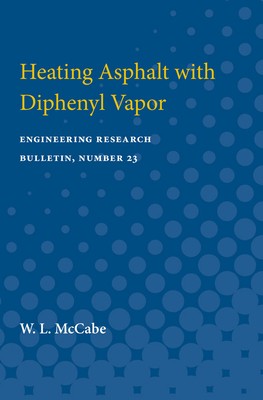
- We will send in 10–14 business days.
- Author: W McCabe
- Publisher: University of Michigan Press
- ISBN-10: 0472751654
- ISBN-13: 9780472751655
- Format: 15.2 x 22.9 x 0.5 cm, softcover
- Language: English
- SAVE -10% with code: EXTRA
Reviews
Description
In the research reported in this Bulletin, asphalt was heated, on a semi-commercial scale, by means of condensing diphenyl vapor. The asphalt was pumped through the inside of the heating tube, and condensing diphenyl surrounded the tube. It was found that this method of heating was entirely practical from a mechanical and control point of view, that the quality of the asphalt was not impaired to the slightest degree even under extreme heating conditions, and that overall heat transfer coefficients of 31 to 44 B.t.u. per hr. per sq. ft. per °F. can easily be obtained. The observed film coefficients of heat transfer on the asphalt and diphenyl sides of the heating surface were found to be reasonably consistent with existing heat transfer theories for analogous cases.
EXTRA 10 % discount with code: EXTRA
The promotion ends in 20d.21:31:40
The discount code is valid when purchasing from 10 €. Discounts do not stack.
- Author: W McCabe
- Publisher: University of Michigan Press
- ISBN-10: 0472751654
- ISBN-13: 9780472751655
- Format: 15.2 x 22.9 x 0.5 cm, softcover
- Language: English English
In the research reported in this Bulletin, asphalt was heated, on a semi-commercial scale, by means of condensing diphenyl vapor. The asphalt was pumped through the inside of the heating tube, and condensing diphenyl surrounded the tube. It was found that this method of heating was entirely practical from a mechanical and control point of view, that the quality of the asphalt was not impaired to the slightest degree even under extreme heating conditions, and that overall heat transfer coefficients of 31 to 44 B.t.u. per hr. per sq. ft. per °F. can easily be obtained. The observed film coefficients of heat transfer on the asphalt and diphenyl sides of the heating surface were found to be reasonably consistent with existing heat transfer theories for analogous cases.


Reviews